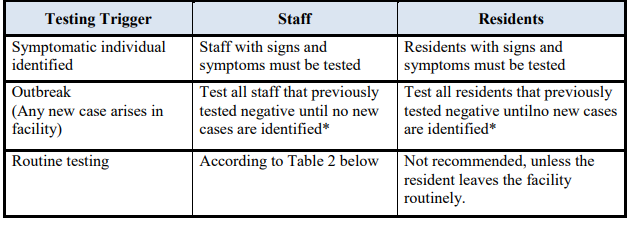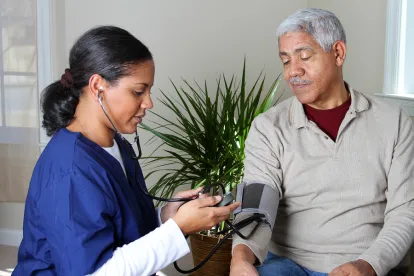On October 9, 2020, DHEC ordered South Carolina’s long-term care communities to begin allowing indoor visitation unless “a reasonable clinical or safety cause” is present in the facility. This represents a stark change in DHEC’s visitation policy during the COVID-19 pandemic. DHEC’s announcement also expressly imposes specific requirements on the facilities for infection control, policies and procedures, and documentation, and facilities can expect that future DHEC surveys will focus heavily on compliance with those requirements.
According to DHEC’s announcement, facilities now must allow in person visitation (both indoors and outside) “unless ‘a reasonable clinical or safety cause” exists. In fact, certain criteria must be met if a facility wants to restrict in person visitation.
In order for a facility to restrict outdoor visitation, one of the following criteria must be present:
- There have been one or more COVID-19 cases among staff and/or residents identified in the facility within the last 14 days.
- Weather conditions do not allow for safe outdoor visitation, including inclement weather or excessively hot or cold temperature.
- Core principles of COVID-19 infection prevention are not being maintained, including routine testing not being performed in accordance with CMS.
In order for a facility to restrict indoor visitation, one of the following criteria must be present:
- There have been one or more COVID-19 cases among staff and/or residents identified in the facility within the last 14 days.
- Core principles of COVID-19 infection prevention are not being maintained, including routine testing not being performed as required by CMS.
- The positivity rate for the county in which the facility is located is greater than 10%.
Note that DHEC has ordered that long-term care facilities must allow compassionate visits under all circumstances (even if one of the above criteria for restriction of indoor or outdoor visitation exists).
DHEC outlines the “core principles” of COVID-19 infection prevention which all South Carolina SNFs and assisted living communities must “adhere to” “at all times” as:
- Visitors unable to adhere to the core principles should not be permitted to visit or should be asked to leave.
- Screening of all people who enter the facility for signs and symptoms of COVID-19 and denial of entry to those who screen positive for signs or symptoms
- Frequent hand hygiene
- Face coverings or masks that cover mouth and nose
- Social distancing of at least six feet
- Signage throughout the facility and visitor education on COVID-19 signs and symptoms, infection control methods, other facility policies (e.g., face coverings/masks, specified entries/exits/pathways, hand hygiene)
- Cleaning and disinfecting of frequently touched surfaces often and of visitation areas after each visit
- Appropriate personal protective equipment (PPE) use by staff
- Effective cohorting of residents (e.g., separate areas dedicated to COVID-19 care)
- Resident and staff testing performed in accordance with CMS
CMS’ resident and staff testing requirements can be found here. CMS’ summary of testing requirements are also shown in the below tables:
Table 1: Testing Summary

Table 2: Routine Testing Intervals Vary by Community COVID-19 Activity Level

In addition to the above infection control principles, DHEC’s facility requirements for visitation are expansive and include:
- Communication of the visitation policy with residents’ family members and keeping them informed of any changes to the policy.
- Establishment of policies and procedures for conducting pre-visit orientation to include ensuring visitors properly wear a face mask or cloth face covering which covers their mouth and nose and that visitors understand the strict requirement of six-foot social distancing.
- Establishment of a schedule for visitation hours and working with prospective visitors individually to schedule a visitation appointment in advance and ensure all have access to visitation. Scheduling should be staggered to allow for adequate social distancing among all visitors, residents, and staff.
- Consideration of prioritizing visitation for eligible residents with emotional distress or other conditions that have been exacerbated by continued isolation.
- Limitation of the duration of each visit based on the criteria listed below in “Visitor Requirements.”
- A maximum of two visitors per resident at one time.
- For outdoor visitation, ensuring the location provides adequate protection from the weather. The use of tents is encouraged, and the most recent CMS guidance notes that nursing homes may apply to use civil monetary penalty (CMP) funds to obtain tents and/or Plexiglas or similar clear dividers.
- A facility that chooses to set up Plexiglas visitation booths must establish policies and procedures to include the use of these three-sided protective and sealed booths and the need to sanitize the booths before and after each visit. The visitation booths must have anti-tipping protections, must have a height that extends at least two feet above all the participants’ heads, and must have a width that extends at least two feet beyond the participants on the sides.
- For outdoor visits, ensuring the outdoor spaces are accessible without visitors entering the facility.
- For indoor visits, establishment of a designated location for visitation which limits movement within the facility, especially by visitors.
- Visitation within a resident’s room should be limited to residents with private rooms. If there is a roommate and the resident’s health status prevents them from leaving their room at all, visitation may occur in the room without the roommate present and the core principles (above) must be strictly followed. Thorough cleaning and disinfection of the room must occur prior to the roommate returning.
- Ensuring that designated visitation spaces are clearly marked to indicate the positions for the resident and visitor during visit are at least six feet apart. The facility must ensure the residents and visitors remain in their designated visitation locations for the duration of the visit.
- Ensuring that staff supervising the residents during visits are trained in patient safety and infection control measures and enforce social distancing and face mask/cloth face covering requirements for the duration of the visit. The facility must ensure that staff maintain visual observation while also providing distance necessary for the privacy of the visit and conversation.
- Ensuring that staff provide appropriate personal care and supervision to residents taking into consideration their individual needs and conditions, including appropriate clothing for the weather for outdoor visits and wandering and other behaviors for both outdoor and indoor visits.
- Ensuring that staff sanitize the designated visitation spaces with EPA-registered disinfectant after each visit at a minimum.
- Establishment of policies and procedures for screening for COVID-19 signs and symptoms, including checking temperatures to assess for fever (100.4°F or greater), for visitors at a designated screening location when the visitor checks in for the visit.
- Documentation of each visitor at the designated screening location, to include, at a minimum, the date of visit, check-in and check-out times, visitor’s signature, visitor contact information (i.e., full name, address, telephone number, and email address), results of their symptom screening, prior COVID-19 test results (if any), relationship to resident they are visiting, and staff that assisted with the visit.
- Provision of alcohol-based hand rub to visitors and signage on proper use.
DHEC’s announcement also lays out resident and visitor requirements for in person visitation.
The resident requirements include:
- Residents that are currently in isolation due to recently testing positive for COVID-19, have signs and symptoms of COVID-19, or currently are in a quarantine or observation period are not eligible for visits except compassionate care visits.
- Residents that are not currently but have previously tested positive for COVID-19 are permitted to participate in visitation only if they no longer require transmission-based precautions in accordance with CDC and DHEC guidelines.
- Residents should not participate in visitation beyond compassionate care visits if they have any other medical conditions that do not allow for safe visitation.
- Residents must not be transported to the visit location through any space designated as COVID-19 care space or space where residents suspected or confirmed to be infected with COVID-19 or under quarantine are present.
- Residents must wear a face mask or cloth face covering, unless a contraindication is present, at all times during the visit, including the transition to and from the outdoor visitation location.
- Residents must be positioned at least six feet away from visitors at all times, unless in an outdoor visitation location that encloses them in a plexiglass visitation booth.
Visitor requirements encompass the following:
- A visitor is limited to a maximum visit of 30 minutes duration unless they provide documentation of either of the following, in which case they may visit for a maximum of one hour:
- A negative result for a COVID-19 PCR or antigen test performed within the last three days; or
- A positive result for a COVID-19 antibody (serology) test performed within the last 30 days.
- Check-in, screening, and check-out times do not count towards visit duration.
- Only two visitors are permitted to visit a resident at one time.
- Visitors should be restricted to children 12 years or older. Special family circumstances warranting children under age 12 to visit can be approved by individual facilities on a case-by-case basis.
- Children must be accompanied by their guardian at all times. The child’s guardian is responsible for ensuring the child follows safety measures, including social distancing and wearing a face mask or cloth face covering appropriately for the duration of the visit. Face masks/cloth face coverings should not be used by any children under the age of two that have been approved by the facility to visit under special family circumstances.
- Visitors may bring pets to outdoor visits if the facility permits and the visitor maintains control of the pet for the duration of the visit. The pet should remain in a carrier, in the visitor’s grasp, or on a leash at all times.
- Visitors must wear a cloth face covering or face mask over their mouth and nose for the duration of the visit, including to and from their vehicle or other mode of transportation. Face shields may not be used in lieu of face masks/cloth face coverings for visitors, though they may be used in addition to the mask or covering if the visitor so chooses.
- Visitors must strictly maintain social distancing for the duration of the visit, including remaining at least six feet away from residents, unless in an outdoor location utilizing a Plexiglas visitation booth as described in “Facility Requirements.” Visitors are not permitted to have any physical contact with residents, including hugging, kissing, holding hands, or any other physical contact.
- Upon arrival for a visit, visitors must go directly to the designated visitor screening location to sign-in and provide contact information.
- In the facility’s designated visitor screening location, visitors must be screened for signs and symptoms of COVID-19, including checking temperature to assess for fever (100.4°F or greater), provide documentation of their COVID-19 test result (if any), and attest that they have not been instructed to be in isolation or quarantine currently.
- Visitors must use alcohol-based hand rub upon entering and exiting the visitation location.
- Visitors are only permitted in the designated visitor screening location and the designated visitation location.
- Visitors must only visit the resident they intended to visit at the designated visitation location.
- Visitors should contact the facility with any questions about the facility’s current visitation policy.
Facilities should be sure to align their visitation policies with the current guidance and maintain effective infection control policies to promote effective and safe visitation for residents. We expect CMS and DHEC to closely monitor compliance with these guidelines and anticipate additional guidance as visitation is offered.



 />i
/>i